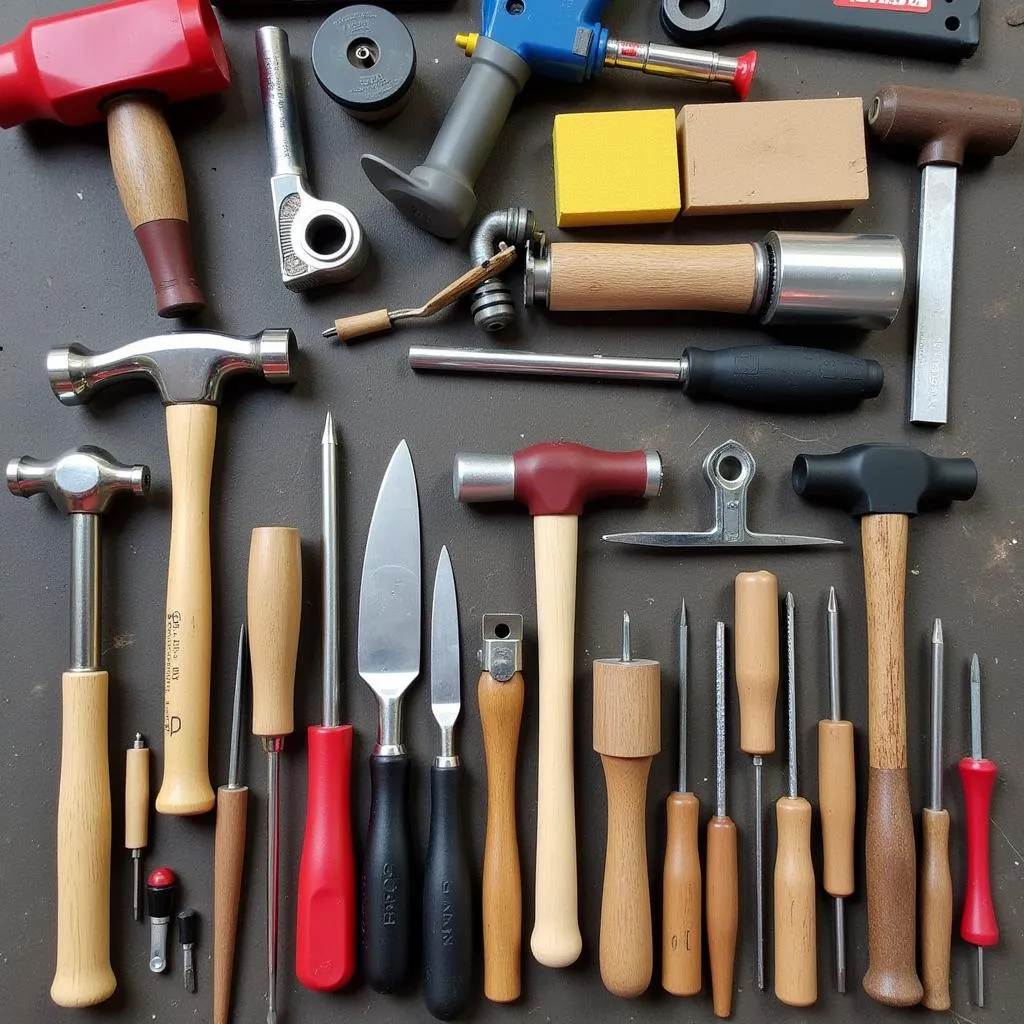Understanding the right tools for car body panel repair is crucial for both professionals and DIY enthusiasts. Whether you’re tackling a minor dent or a more complex restoration, having the right equipment can make all the difference in achieving a seamless and professional-looking finish.
Navigating the World of Car Body Panel Repair Tools
Car body panel repair involves a variety of tasks, each requiring specialized tools. Let’s delve into some of the most essential equipment:
1. Hammers and Dollies: The Dynamic Duo
Hammers and dollies are the backbone of any car body repair toolkit. Hammers, used to shape and smooth out dents, come in various forms, including:
- Body hammer: The workhorse for general shaping.
- Pick hammer: Ideal for smaller dents and high spots.
- Sledgehammer: Used with a dolly for larger repairs.
Dollies, on the other hand, provide a backing surface when hammering, ensuring the metal is evenly worked. Common types include:
- General purpose dolly: Versatile and used in most repairs.
- Toe dolly: For reaching confined areas.
- Heel dolly: Used on edges and curves.
Using the right combination of hammer and dolly is essential for preventing further damage and achieving a smooth, contoured finish.
2. Shaping and Finishing: Achieving Perfection
Once the dent is roughly shaped, a range of tools come into play for refining the surface and preparing it for filler:
- Body files: Used to smooth out high spots and imperfections.
- Grinders and sanders: Essential for feathering edges and creating a smooth transition between the repaired area and the surrounding paintwork.
- Sanding blocks: Provide a flat surface for sanding and come in various grits for different stages of repair.
3. Body Filler: Filling the Gaps
Body filler, often referred to as “bondo,” plays a critical role in restoring the panel’s smooth surface. Key tools for applying and shaping filler include:
- Body filler spreaders: Used to apply an even layer of filler to the damaged area.
- Mixing boards and spatulas: Ensure proper mixing of the filler and hardener.
- Sandpaper: Used to shape and smooth the filler once it hardens.
4. Welding Equipment: For Structural Repairs
In cases of significant damage, welding equipment becomes essential. Common welding methods in car body repair include:
- MIG (Metal Inert Gas) welding: A versatile option for most repairs.
- TIG (Tungsten Inert Gas) welding: Offers greater precision for intricate work.
Remember, welding requires specialized training and safety precautions.
Essential Tips for Choosing Car Body Panel Repair Tools
- Quality over quantity: Investing in high-quality tools ensures durability and better results.
- Consider your skill level: Start with basic tools and gradually expand your kit as your skills develop.
- Read reviews: Research and compare different brands and models before making a purchase.
Frequently Asked Questions
Q: What is the best hammer for car body work?
A: The best hammer depends on the specific repair. A body hammer is versatile for general shaping, while a pick hammer is ideal for smaller dents.
Q: What grit sandpaper should I use for car body repair?
A: Start with a coarser grit (around 80) for shaping filler and gradually move to finer grits (400 or higher) for a smooth finish.
Q: Can I repair rust holes with body filler?
A: While filler can temporarily fill small rust holes, it’s not a permanent solution. Proper rust repair involves cutting out the affected area and welding in new metal.
Q: What safety precautions should I take when using car body repair tools?
A: Always wear safety glasses, a dust mask, and gloves when grinding, sanding, or welding.
Need Help with Your Car Body Panel Repair?
For professional assistance and expert advice, contact us via WhatsApp at +1(641)206-8880 or email us at [email protected]. Our team of experienced technicians is available 24/7 to answer your questions and provide top-notch car repair services.
Explore More:
Remember, having the right car body panel repair tools can transform your repair experience, enabling you to achieve professional-level results.


